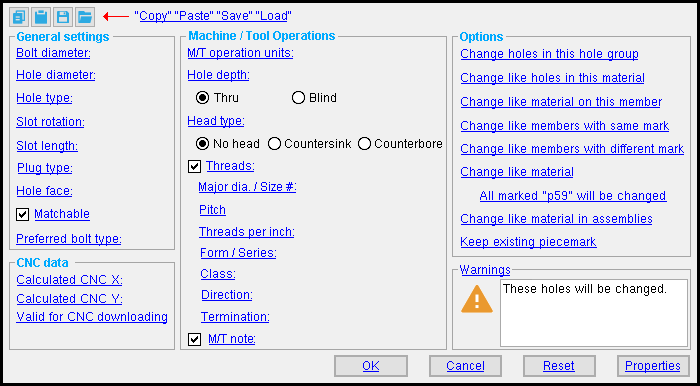The 3D Hole Edit window: ( hole number printed in title bar, Modeling )
Also see :
- Important information about 3D holes (topic)
- Grayed out fields (indicate mixed entries or that the field is disabled)
 " Copy " " Paste " " Save " " Load " buttons :
" Copy " " Paste " " Save " " Load " buttons :
------ General settings ------
Bolt diameter: The diameter (inches or mm) of the shank of the bolt to be inserted into the hole you are editing. If you Match Holes and choose to add bolts through those holes, the added bolts will be the " Bolt diameter " specified for the matched holes.
| diameter |
|
Making an entry: You can either type in any diameter (inches or mm), or you can select a bolt diameter from the combo box (
). The diameters that are listed in the combo box come from Home > Project Settings > Job > Bolt Settings > the " Available bolts " list.
Note: The " Hole diameter " is for this bolt diameter is calculated based on the connection design method and the " Hole type " selected below. For AISC connection design methods, this calculation is done per Table J3.3 or Table J3.3M ( AISC Thirteenth Edition , p. 16.1-105). Also, when a bolt is Added to this hole, Add Bolts looks here to determine the diameter of bolt that is required. If the " Hole type " is ' User slot #1 ' or ' User slot #2 ', the system-calculated slot length comes from Home > Project Settings > Job > User Slot Lengths .
Report Writer: MemberMaterial.Material.SubMaterial.HoleGroup.BoltDiameter
Advanced Selection: BoltDiameter
Parametric module: BoltDiameter
Hole diameter: A system-calculated or user-entered distance. On a ' Standard round ' hole, the calculated value will be 1/16 inch larger than the input bolt diameter.
To add a CNC mark: Enter a diameter of ' 0 ' (zero). An "X" is used to represent a CNC mark in a view (or, for that matter, on a detail drawing).
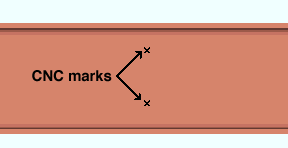
Status Display: Hole status > Hole diameter
Report Writer: MemberMaterial.Material.SubMaterial.HoleGroup.Diameter
Advanced Selection: Diameter
Parametric module: Diameter
Hole type: Standard round or Short slot or Oversized round or Long slot or Cope hole or Erection pin hole or Anchor bolt hole or Plug weld hole or Grout or User slot #1 or User slot #2 or Vent/Drain .

A ' Standard round ' hole is perfectly round and has a " Hole diameter " that is typically 1/16 inch larger than the input bolt diameter. See Table J3.3 or Table J3.3M ( AISC Thirteenth Edition , p. 16.1-105).
A ' Short slot ' is oblong in shape, has a diameter that is typically 1/16 inch larger than the input bolt diameter, and has a relatively short " Slot length " (1 5/16 inch for a 1 inch diameter bolt). A short slot is, by default, matchable ("
Matchable "). The matched hole will be standard round.
An ' Oversized round ' hole typically inputs a " Hole diameter " 3/16 inch larger than the input bolt diameter. See Table J3.3 or Table J3.3M ( AISC Thirteenth Edition , p. 16.1-105). An oversized round hole is, by default, matchable ("
Matchable "). The matched hole will be standard round.
A ' Long slot ' is oblong in shape, has a diameter 1/16 inch larger than the input bolt diameter, and has a relatively long " Slot length " (2 1/2 inch for a 1 inch diameter bolt). A long slot is, by default, matchable ("
Matchable "). The matched hole will be standard round.
A ' Cope hole ' is a hole in the radius of a cope. By default, cope holes are not matchable ("
Matchable ").
An ' Erection pin hole ' is a hole on the end of a column for use by a crane to lift the column into place (see show erection pin holes on columns ). By default, erection pin holes are set to be not matchable ("
Matchable ").
An ' Anchor bolt hole ' is a hole for anchor bolts in a column base plate. Holes must be of this type in order for them to be automatically dimensioned when the " Dimension anchor bolt layout " option is selected during erection view regeneration. By default, anchor bolt holes are not matchable ("
Matchable ").
A ' Plug weld hole ' is for adding to a material before the material is plug welded . By default, plug weld holes are not matchable ("
Matchable ").
A ' Grout ' hole may be used for pouring grout under a base plate. By default, grout holes are not matchable ("
Matchable ").
' User slot #1 ' and ' User slot #2 ' are slots whose " Slot length " are set, based on the " Bolt diameter ," from user-entered length settings maintained at Home > Project Settings > Job > User Slot Lengths . A use slot is, by default, matchable ("
Matchable "). The matched hole will be standard round.
' Vent/Drain ' is a vent hole or drain hole for galvanizing. For this type of hole, you can enter a " Plug type ." When you select this type of hole, the " Hole diameter " resets to the value that is specified as the " Default vent/drain hole diameter " on the Galvanizing Settings window. By default, vent/drain holes are not matchable ("
Matchable ").
Status Display: Hole status > Hole type
Report Writer: MemberMaterial.Material.SubMaterial.Hole.HoleTypeDescription
Advanced Selection: Type
Parametric module: Type
Slot rotation: A positive or negative number from 90 to -90 degrees. This applies when the " Hole type " is ' Long slot ' or ' Short slot '. Slot rotations can be modeled to a precision of 0.1 degree.
| when the hole group X axis
is horizontal (<==>) |
when the hole group X axis
is vertical |
| Example of Slot Rotation | |
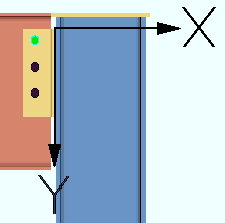
|
Set Hole Group Reference Point shows the hole group X axis as horizontal (parallel with the beam). The slots on this clip angle are rotated 90 or -90 degrees, thus making them vertical. |
' 0 ' (zero) degrees points the slot so that its length is parallel to the " Hole group rotation ." The " Hole group rotation " is the hole group X axis that is shown when you Set Hole Group Reference Point .
A ' positive number ' of degrees rotates the slot counterclockwise from its ' 0 ' orientation.
A ' negative number ' of degrees rotates the slot clockwise.
Status Display: Hole status > Slot rotation
Report Writer: MemberMaterial.Material.SubMaterial.HoleGroup.SlotRotation
Advanced Selection: SlotRotation
Parametric module: SlotRotation
Slot length: The system-calculated or user-entered distance (in the primary dimension " Units " or other units ) between the two points farthest from one another on the perimeter of a slot. This applies when the " Hole type " is ' Long slot ' or ' Short slot ' or ' User slot #1 ' or ' User slot #2 ' .
| slot length |
|
|
A ' system -calculated slot length ' is -- for a ' Long slot ' or a ' Short slot ' -- the standard slot length based on the " Bolt diameter " and " Hole type " per the connection design method. For an AISC design code, the calculation is done per Table J3.3 or Table J3.3M ( AISC Thirteenth Edition , p. 16.1-105).. For a ' User slot #1 ' or ' User slot #2 ', the system-calculated slot length comes from Home > Project Settings > Job > User Slot Lengths .
A ' user-entered slot length ' must be entered after the " Hole type " has been established. If you have entered a distance here and want to replace that distance with the standard slot length, simply go back and select the " Hole type " that you want again.
Status Display: Hole status > Slot length
Report Writer: MemberMaterial.Material.SubMaterial.HoleGroup.SlotLength
Advanced Selection: SlotLength
Parametric module: SlotLength
Plug type: No Plug or Zinc Plug or Plug Weld or Aluminum or Epoxy . This applies when the " Hole type " is ' Vent/Drain '.
' No Plug ' should be selected if there is no reason for plugging the vent/drain hole.
' Zinc Plug ' or ' Plug Weld ' or ' Aluminum ' or ' Epoxy ' are various types of plugs or methods for plugging vent/drain holes after galvanizing in order to seal the hole and smooth the surface of the material.
Status Display: Hole status > Plug type
Hole face: read-only . This reports the face that the hole is to be drilled or punched from. The faces of different materials are illustrated below.
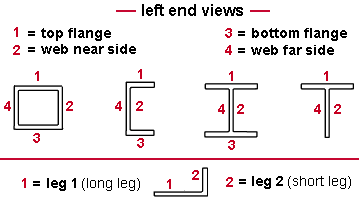
Report Writer: MemberMaterial.Material.SubMaterial.Hole.MaterialFaceDescription
|
If this box is checked (
) and the hole(s) are in a material that is face-to-face with a beam, column or brace main material, the matching holes phase of Create Solids automatically matches holes to the member main material and a later phase of Create Solids inserts bolts through the matching holes. Also, when this box is checked, you can use Model > Hole > Match to match the hole(s) to a different material.
If the box is not checked (
), the hole(s) will not be matched to other material during Model > Hole > Match or during the matching holes phase of Create Solids .
Note: Certain " Hole types " are, by default, set to not matchable ("
Matchable ").
Status Display: Hole status > Matchable
Advanced Selection: Matchable
Preferred bolt type: Auto or A325N or etc. If you Match Holes and choose to add bolts through those holes, the added bolts will be the " Preferred bolt type " specified for the matched holes.
If ' Auto ' is selected, Home > Project Settings > Job > Bolt Settings > " Default non-moment bolt type for this job " or " Default moment bolt type for this job " sets the bolt type when bolts are added to this hole.
Selecting a ' specific bolt type ' for this field overrides the choice made at Home > Project Settings > Job . The types of bolts that are listed in the list box (
) come from Home > Project Settings > Job > Bolt Specifications .
Status Display: Hole status > Preferred bolt type
Report Writer: MemberMaterial.Material.SubMaterial.HoleGroup.BoltTypeDescription
------ CNC (Computer Numerically Controlled) data ------
| The hole number displayed in this window's title bar is the hole that settings in this section apply to. The hole number also identifies holes under " Select other " or " Edit other " in the context menu and in the balloon description when your mouse pointer hovers a hole. The hole number is not displayed for multi-hole edit . |
Calculated CNC X: read-only . The calculated distance (in the primary dimension " Units ") from the end of the material along the X material axis to the center of the hole, slot or mark. This should exactly match the equivalent coordinate that is reported in a CNC file that is in the DSTV format.
Report Writer: MemberMaterial.Material.SubMaterial.Hole.ReferenceLocationX
Calculated CNC Y: read-only . The calculated distance (in the primary dimension " Units ") along the Y material axis to the center of the hole, slot or mark. This should exactly match the equivalent coordinate that is reported in a CNC file that is in the DSTV format.
For web holes, this is the distance from the bottom flange to the center of the hole/slot/mark.
For flange holes, this is the distance from the web center line and will be negative (-) if the CNC item is on the far side of the center line, positive (+) if the CNC item is on the near side of the center line.
Report Writer: MemberMaterial.Material.SubMaterial.Hole.ReferenceLocationY
Valid for CNC downloading: ![]() or
or ![]() .
.
If this box is checked (
), this hole is permitted to be downloaded to a CNC file using the SDS2 CNC Module .
If the box is not checked (
), then the hole will not appear in the CNC file for the member or material that the hole is a part of. The hole will have to be fabricated manually. Depending on the CNC error handling methods that you use, you may want to do this for holes that would otherwise generate error messages .
Report Writer: MemberMaterial.Material.SubMaterial.Hole.ShouldBeValid
Advanced Selection: ShouldBeValid
Parametric module: ShouldBeValid
------ Machine / Tool operations ------
| Please note: For these options to be enabled, the " Hole type " must be ' Standard round '. |
M/T operation units: ![]() Imperial or
Imperial or ![]() Metric .
Metric .
'
Imperial ' lets you make distance entries to fields in this section in the same way that you make distance entries everywhere else in SDS2. How you make distance entries primarily depends on the primary dimension " Units " that are specified in Home > Project Settings > Fabricator > Detailing > Drawing Presentation > the " Primary Dimensions " tab. Be aware, though, that you can still make entries in other units .
'
Metric ' requires that you make distance entries to the fields in this section in millimeters. These distance-entry fields include " Depth " (blind hole), " Diameter " (countersink), " Diameter " (counterbore), " Depth " (counterbore), etc.
Hole depth: ![]() Thru or
Thru or ![]() Blind . The " Hole type " for a blind hole must be ' Standard round '.
Blind . The " Hole type " for a blind hole must be ' Standard round '.
|

'
Thru ' makes the hole the full depth of the ply of the material to which the hole has been added.
'
Blind ' plus a " Depth " results in a blind hole that is the specified " Depth ." The blind hole will be visible on the " Hole face " of the material, but will not be visible on the opposite face.
VIDEO 
Hole information for a blind hole is shown on a legacy miscellaneous member detail. "Depth" is the cross-sectional length of the blind hole in the " M/T units ."

A blind hole's depth is the distance from the material's surface (the " Hole face ") to the bottom of the hole.

A label on a member detail indicating that the depth of a blind hole is 0.75 inch. Status Display: Hole status > Thru hole and Blind hole and Blind hole depth
Head type : ![]() No head (straight) or
No head (straight) or ![]() Countersink or
Countersink or ![]() Counterbore . The " Hole type " for a countersink or counterbore hole must be ' Standard round '.
Counterbore . The " Hole type " for a countersink or counterbore hole must be ' Standard round '.
|

'
No head (straight) ' results in a perfectly cylindrical hole that is the same diameter (the " Hole diameter ") at any cross section across its entire length.
'
Countersink ' plus a " Diameter " and " Angle " prepares the hole to receive the head of a bolt or screw so that the head will not project beyond the face of the material.
VIDEO 
The label for a countersink hole with threads is shown on the member detail.

A label on a member detail that calls out a 0.81 inch hole with a countersink diameter of 1.63 inch and an angle of 82 degrees. "Diameter" is the countersink hole's maximum diameter (in the " M/T units ").. The hole is at its maximum diameter at the surface of the material.
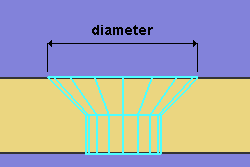
|
The diameter of the hole at the end opposite to the countersink is the " Hole diameter " or, if the hole is threaded, the " Major dia ." |
"Angle" is the angle of countersink (in degrees). This is the angle between opposite sides of the countersink conical bore. You can enter any number of degrees that you like, or you can select a value from the combo box menu.
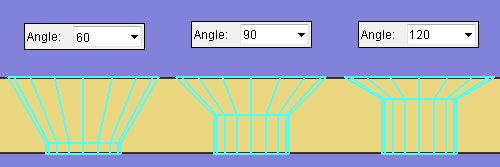
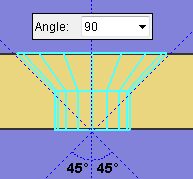
|
The specified " Angle " (' 90 ' in this example) sets the angle between opposite sides of the countersink cone. |
Status Display: Hole status > Countersink and Countersink diameter and Countersink angle
'
Counterbore ' is like ' Countersink ', except that the hole is bored to receive a cylindrical head rather than a conical head.
VIDEO 
Hole information for a counterbore hole is shown on a legacy miscellaneous member detail.
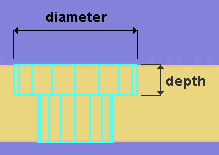
A counterbore is defined by its " Diameter " and a " Depth ."

A label on a member detail that calls out a 0.81 inch hole with a counterbore diameter of 1.63 inch and a counterbore depth of 0.25 inch. "Diameter" is the counterbore diameter (in the " M/T units ") at the " Hole face " surface of the material.
"Depth" is the length of counterbore (in the " M/T units "). This distance is from the material's surface (the " Hole face ") to the bottom of the counterbore.
Status Display: Hole status > Counterbore and Counterbore diameter and Counterbore depth
Threads: ![]() or
or ![]() . The " Hole type " for a hole with threads must be ' Standard round '. The hole can be a blind hole or thru hole or have any " Head type ."
. The " Hole type " for a hole with threads must be ' Standard round '. The hole can be a blind hole or thru hole or have any " Head type ."
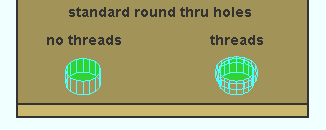
|
Most thread information is not modeled, but the thread information does affect the hole symbol callout label that may be generated during auto detailing or when you use the Add Material Callout tool. |
If this box is checked (
), options such as " Threads per inch " or " Pitch " and " Direction " are enabled, and you can use them to define hole threads. Most thread settings do not affect the model, but will affect the hole symbol callout label for a threaded hole.
If the box is not checked (
), then hole thread settings are disabled, and the hole will not be threaded.
Status Display: Hole status > Threads
Major dia. / Size #: The nominal diameter of the threaded hole. This is the threaded portion of a hole's largest diameter or outside diameter. By default, the major diameter is the same as the " Hole diameter ." " Major dia. " affects the hole symbol callout label for a threaded hole.
When " M/T units " is ' Imperial ', a diameter symbol ø precedes the major diameter value, which is expressed in decimal inches.

|
ø.8 1 = " Major dia. " (inch) 16 = " Threads per inch " UNC = " Form / Series " 2 = " Class " RH = " Direction " |
When " M/T units " is ' Metric ', the letter M precedes the major diameter, which is expressed in millimeters. In the example below, the major diameter is 21 mm.

|
M21 = " Major dia. " (mm)
1.588 = " Pitch " 5H/5g = " Class " |
Status Display: Hole status > Thread major dia./size #
Threads per inch: This is the count of the threads per inch (TPI) along the depth of the hole. This applies when " M/T units " is ' Imperial '. If you change the " M/T units " to ' Metric ', the name of this field will be changed to " Pitch " and the TPI value you entered will be converted to pitch. " Threads per inch " affects the hole symbol callout label for a threaded hole. TPI does not affect the representation of a hole in Modeling .

|
ø.81 = " Major dia. " (inch) 16 = " Threads per inch " UNC = " Form / Series " 2 = " Class " RH = " Direction " |
| Threads per inch (TPI) is the inverse of " Pitch ." For example, if the threads per inch are 32, then 1/32 (the inverse) = 0.03125 inch. Converting this to mm gives you: 0. 0.031250 inch x 25.4 mm/inch = 0.79375 mm. Thus, in a standard table of screw threads, a TPI of 32 is equal to a pitch of 0.7938 mm. |
Status Display: Hole status > Threads per unit
Pitch: The distance between thread peaks in millimeters. Pitch is the inverse of threads per inch, but expressed in mm: In other words, pitch is millimeters per thread. " Pitch " is available as an entry field when the " M/T units " is ' Metric '. The pitch value that you enter here is recorded in the hole symbol callout label for a threaded hole. Pitch does not affect the representation of a hole in Modeling .

|
M21 = " Major dia. " (mm)
1.588 = " Pitch " 5H/5g = " Class " |
Status Display: Hole status > Threads per unit
Form / Series: None or UNC (coarse) or UNF (fine) or UNEF (extra fine).. This applies when " M/T units " is ' Imperial ' and " ![]() Threads " is checked. It affects the hole symbol callout label for a threaded hole. In the example below, the series is UNC (coarse).
Threads " is checked. It affects the hole symbol callout label for a threaded hole. In the example below, the series is UNC (coarse).

|
ø.81 = " Major dia. " (inch) 16 = " Threads per inch " UNC = " Form / Series " 2 = " Class " RH = " Direction " |
' None ' results in the form / series not being included in the hole callout label. If ' None ' had been selected for the above example, the label would read: ø.81-16-2B-RH .
' UNC ' stands for Unified National Course. For the example above. ' UNC ' was selected as the "Form / Series," and therefore the label reads ø.81-16UNC-2B-RH .
' UNF ' stands for Unified National Fine. If ' UNF ' had been selected for the example above, the label would read ø.81-16UNF-2B-RH .
' UNEF ' stand for Unified National Extra Fine. For the example above. ' UNEF ' was selected as the " Form / Series ," and therefore the label reads ø.81-16UNC-2B-RH .
Status Display: Hole status > Thread form/series
Class: 1 or 2 or 3 or 6H/6g or etc. . " Class " is a designation of tolerance, or the closeness of fit between two mating parts. You can type in any class you like, or you can select a class from the combo box menu. The class you specify is recorded to the thread information line on the hole symbol callout label for a threaded hole. Class does not affect the representation of a hole in Modeling . In the example below, the class is 2, and B indicates that the thread is internal.

|
ø.81 = " Major dia. " (inch) 16 = " Threads per inch " UNC = " Form / Series " 2 = " Class " RH = " Direction " |
When " M/T units " is ' Imperial ':
' 1 ' indicates generous tolerance.' 2 ' designates normal production. If no class is designated, common practice is to assume that 2 is the class. .
' 3 ' designates high accuracy.
Note: The letter B in the imperial example shown above indicates internal thread, i.e., threads in a hole, the female part. A nut would also have internal threads. The letter A would indicate external threads, i.e., threads in a screw, the male part.

M21 = " Major dia. " (mm)
1.588 = " Pitch "
5H/5g = " Class "When " M/T units " is ' Metric ':
' 6H/6g ' indicates general purpose. If no class is designated, common practice is to assume that 6H/6g is the class.' 4H/4g ' and ' 5H/5g ' and ' 7H/7g ' are a few other selections that you can make to
As stated above , you can type almost any value you like to this combo box .
Direction: ![]() RH or
RH or ![]() LH . In the example below, the direction is RH (right-handed).
LH . In the example below, the direction is RH (right-handed).

|
ø.81 = " Major dia. " (inch) 16 = " Threads per inch " UNC = " Form / Series " 2 = " Class " RH = " Direction " |
'
RH ' stands for right-handed. For the example above, ' RH ' was selected as the " Direction ," and therefore the label reads ø.81-16UNC-2B-RH . If neither RH or LH is designated in the label, common practice is to assume that the threads are right-handed.
'
LH ' stands for left-handed. If ' LH ' had been selected as the " Direction " for the example above, that label would read ø.81-16UNC-2B-LH .
Status Display: Hole status > Right hand thread direction and Left hand thread direction
Termination: ![]() Thru or
Thru or ![]() Thread depth .
Thread depth .
'
Thru ' specifies that the threads be along the entire depth of the hole.
'
Thread depth ' specifies that the threads be the depth that you enter here. An additional annotation will appear on the hole symbol that will be auto detailed on the member detail on which this hole appears. .

The " Depth " specified for this example is ' 0.5 ' inch. "Depth" is the length of the threads (in the " M/T units "). This distance is from the material's surface (the " Hole face ") to the depth of the hole at which you want the threads to end.
Status Display: Hole status > Thread thru and Thread depth
M/T note: Any text can be entered, including Latin 1 characters 0160 to 0255 . To enter special characters, hold down the Alt key and type in the number, or copy and paste from the Character Map that can be launched from your operating system's Accessories menu. To enter multiple lines, press the Enter key where you want a line break. The line(s) of text that you enter will appear below other lines in the hole symbol callout label for a M/T hole.

|
TYPICAL is the " M/T note " in this example of a hole callout label. |
|
These options do not appear if you are editing multiple holes . Tip : Leave all of these options not checked ( |
Change all holes in this hole group: ![]() or
or ![]() . The quantity reported here is the total number of holes in the hole group, including the one hole that you clicked on to open this window.
. The quantity reported here is the total number of holes in the hole group, including the one hole that you clicked on to open this window.
If this box is checked (
), the settings on this window will be applied to all holes included in the reported quantity.
If the box is not checked (
), only the single hole you clicked on before this window opened will be changed.
Change all like holes in this material: ![]() or
or ![]() . The quantity reported here is the number of like holes in this material, including all holes in the hole group that the hole you clicked on is in.
. The quantity reported here is the number of like holes in this material, including all holes in the hole group that the hole you clicked on is in.
If this box is checked (
), the settings on this window will be applied to all holes included in the reported quantity.
Definition: "Like holes" are holes with the same settings (diameter, hole type, etc.) as the hole you are editing.
Change all like material on this member: ![]() or
or ![]() . The quantity reported here is the number of pieces of like material on this member only (including the material you are working on).
. The quantity reported here is the number of pieces of like material on this member only (including the material you are working on).
If this box is checked (
), the settings on this window will be applied to all like holes on all like materials.
Definition: Like material is material with the same submaterial mark as the material you are editing holes on plus any material on the same member or a different member with holes that match the material you are working on.
Change all like members with same mark: ![]() or
or ![]() . The quantity reported here is the number of members that have the same member piecemark as the member you are working on. If the member you're working on is the only member, this number will be 1.
. The quantity reported here is the number of members that have the same member piecemark as the member you are working on. If the member you're working on is the only member, this number will be 1.
If this box is checked (
), the settings on this window will be applied to all like holes on all like material that is submaterial of members included in the reported quantity.
Definition: A like member is a member which has like material with the same mark(s) as the like material that exists on the member you are editing.
Change all like members with different mark: ![]() or
or ![]() . The quantity reported here is the number of members that exist in the 3D model that do not have the same member piecemark as the member you are working on but do have submaterials with the same submaterial mark as the submaterial that contains the hole you are working on. If no such members exist, then this number will be zero (0).
. The quantity reported here is the number of members that exist in the 3D model that do not have the same member piecemark as the member you are working on but do have submaterials with the same submaterial mark as the submaterial that contains the hole you are working on. If no such members exist, then this number will be zero (0).
If this box is checked (
), the settings on this window will be applied to all like holes on like material on the members included in the reported quantity.
Change all like material: ![]() or
or ![]() . This quantity reported here is expressed in the form " x of y ," where " x " is the number of materials that will be operated on and " y " is the total number of those same materials. The indented line beneath this line tells you the submaterial mark of the materials that will be changed.
. This quantity reported here is expressed in the form " x of y ," where " x " is the number of materials that will be operated on and " y " is the total number of those same materials. The indented line beneath this line tells you the submaterial mark of the materials that will be changed.
If this box is checked (
), the revised settings on this window will change all like holes on the total quantity of materials whose piecemark is identified here.
Change all like material in assemblies: ![]() or
or ![]() . The quantity reported here is the number of pieces of like material that exist in the 3D model and that were originally added to the model by Adding an assembly.
. The quantity reported here is the number of pieces of like material that exist in the 3D model and that were originally added to the model by Adding an assembly.
If this box is checked (
), the settings on this window will be applied to all like holes in like material in assemblies included in the count.
If this box is checked (
), the materials changed using this operation will keep the same submaterial piecemark . Like materials whose holes have not been changed will be assigned a different piecemark. This may result in details being " Marked for detailing " in order to keep details and detail sheets synchronized with your piecemark changes.
If the box is not checked (
), SDS2 piecemarking will change the piecemark of those materials whose holes have been changed. Like materials whose holes have not changed will keep their existing piecemark.
| The following warnings ( " in quotes " ) may appear on this window. They tell you the consequences of pressing " OK . " If you press " Cancel ," the warnings do not apply. |
" Connection will be changed to a Graphical User connection " tells you that the material associated with the hole(s) you are editing is currently part of a system connection , but will be changed to a graphical user connection , which means that it will not be altered during Process and Create Solids .. When a member has a graphical connection on either its right or left end, the " Connection " for that end is marked as "
Graphical " on that member's edit window.

" This member will need to be redetailed " tells you that changing the hole settings will cause the associated member(s) listed next to this message to need to be redetailed. Affected members will be marked for detailing when you press " OK ." On the edit windows of the affected members, " Marked for detailing " will be set to ' YES ' (
).
" Detail drawing marked as completed. Member will not be redetailed " tells you that the detail complete flag is on for the affected member (which means it can't be redetailed). You will need to turn the detail complete flag off if you want to redetail.
" This member will need to be reprinted " tells you that you have printed the detail for the member whose hole settings you are changing.
" This member is approved. Approval status will be reset " indicates that if you press " OK ," the " Submitted for approval " status of the affected members will be changed back to ' ***NOT SET*** '.
" This member has been released for fabrication " tells you that a " Released for fabrication " date has been set.
" This member has been fabricated " tells you that a " Fabrication completed " date has been set.
"OK" (or the Enter key) completes the Edit Hole operation and applies the settings on this window to the hole(s).
"Cancel" (or the Esc key) closes the window and ends the Edit Hole operation without changing any holes.
"Reset" undoes all changes made to this window since you first opened it. The window remains open.
"Properties" opens the Edit Properties window, on which you can make entries to custom properties . If, at the time it was created, your current Job was set to use a legacy flavor, the window that opens is named Custom Properties , not Edit Properties .
The Edit Properties window can also be used to read "
Log " entries or review or type "
Notes ."
Tip: Model > Hole > Properties is an alternative to this button. It opens the Edit Properties window directly, without your first having to edit holes.
